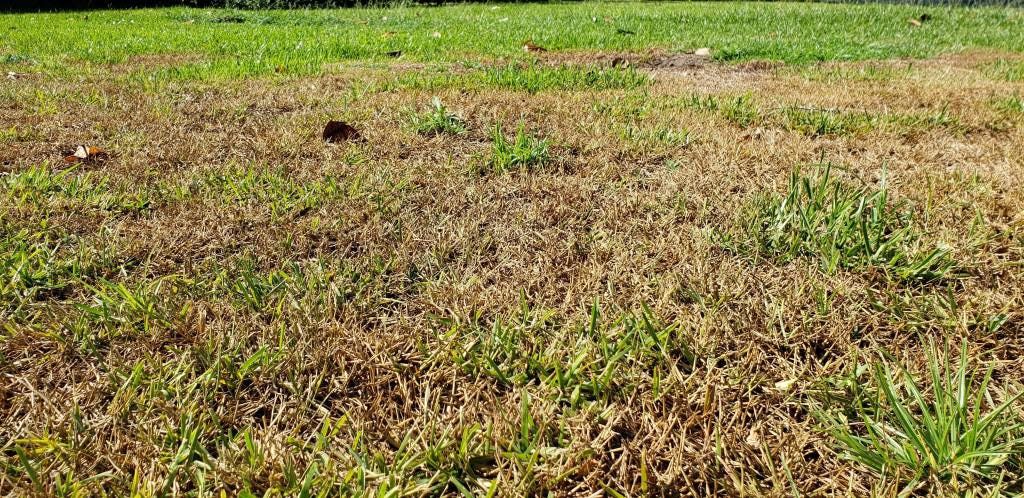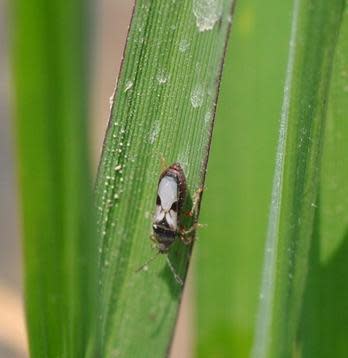Campbell Vaughn: Seeing patches of dead grass? It could be chinch bugs

I have a love hate relationship with St. Augustine grass. When it is acting right, it is the best yard grass around. When it isn’t, it can frustrate you to no end. I have St. Augustine in the front lawn of my house that has probably been there since the house was built in the 1950s and it looks great right now. Unfortunately, the calls are starting, and after a few site visits, I know that “they” have arrived. Similar to Ohioans to Hilton Head for the Fourth of July, chinch bugs have begun to take over our St. Augustine lawns.
If it is hot and dry, they are going to come. Chinch bugs (and I assume people from Ohio) really love the heat, and it was only a matter of time. The raging heat and super dry weather a couple weeks ago were ideal for chinch bug infestations.
More from Campbell Vaughn: In extreme heat, how much should you water your lawn? The answer requires math.
Also: Campbell Vaughn: A look at the nitty gritty on lawn fertilizers
My family likes to ride our golf cart in the evenings and I use it as an opportunity to not only get out of the house, but to also see what is happening in the landscape. It is what we refer to at the UGA Extension as extensive turf grass analysis. Sometimes it happens on golf courses as well. I get to see all kinds of lawns, each with their own level of maintenance. And when passing a St. Augustine lawn, chinch bug damage is easy to spot.
How to spot an infestation
Infestations will be notable where you will see wilting of the grass in distinct areas and the turf turning yellow. The damage will always be in full sun in the hotter and drier spots in the lawn especially next to curbs, driveways and walkways where the heat radiates for long periods. Chinch bugs will attack most of the summer – sometimes beginning as early as May – with multiple generations in a season. With untreated, heavy infestations, chinch bugs can destroy a St. Augustine lawn in a matter of a week – like graveyard dead.

Adult chinch bugs are black and about 1/6-inch long with their wings folded over the back forming a white or silver cross-shaped mark. The white markings will look a little different depending on the life stage. Young chinch bug nymphs are about the size of a pin head, red to orange in color with a white band across their back. The full-grown nymph (just before the adult stage) is black and has a white spot on the back between the wing pads. Like most insects, the nymphs actually do more damage than the adults.
For subscribers: It's getting hot! Cool off at these splash pads and pools this summer
Things to do: Picking a picnic place? Augusta-area residents suggest 5 spots to dine outdoors
How to fight chinch bugs
My first line of defense is to try and make sure to keep the soil moist in the hot dry areas. A lot of times that alone can keep chinch bugs at bay. If you are seeing the signs of damage in small parts of the yard, applying spot treatment via granular or liquid insecticides usually works well. Granular herbicides are a little easier to apply as long as you can water them in deep. Spot treatment allows the conservation of natural enemies such as native parasites, which can play a significant role in chinch bug management.
Synthetic pyrethroid insecticides are effective in control of chinch bugs, but most of them don’t provide much residual control. These include all the synthetic pyrethroid insecticide names that end in “thrin,” such as bifenthrin, cyfluthrin (Bayer BioAdvanced) and lamda-cyhalothrin (Spectracide) or permethrin. The Bayer Product Complete Insect Killer has a combination of b-cyfluthrin and imidacloprid (which is systemic) so it provides a longer residual control.
It's also time to fight mole crickets
Near July Fourth is also the time of year to treat for mole crickets in bermuda grass. If you have had them in the past or have seen some adult mole crickets earlier this year, it is time to be proactive. Mole cricket nymphs are hatching now and the little ones do the most amount of damage, so get them now before the heavy damage can take place. Similar insecticides to the chinch bug treatments work well on mole cricket infestations.
Keep an eye out for these pests, because they can cause some serious damage if left untreated. Treating them now is a whole lot easier than re-sodding your lawn next spring.
Reach Campbell Vaughn, the UGA Agriculture and Natural Resource agent for Richmond County, by e-mailing augusta@uga.edu.
This article originally appeared on Augusta Chronicle: Campbell Vaughn: Seeing patches of dead grass? It could be chinch bugs

